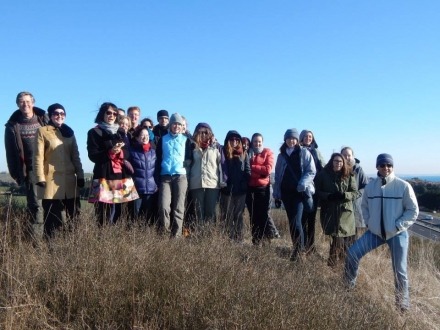The tumulus of Kersobleptes

In the first entry in this blog, Elizabeth Minchin mentioned that, after arriving at Istanbul’s Atatürk Airport last Friday, I grabbed a car and drove down to Çanakkale. I was pretty tired, and did start doubting the wisdom of this venture when I found that heavy snowfalls had left some lanes closed even on major highways, but I made it.
Çanakkale is a fun, bustling town, but my real aim of going there was to visit Mt Ida, an hour or two south of the town. Mt Ida has various mythological associations, including of course being the location of the judgement of Paris. Sadly the next day the jetlag had thoroughly caught up with me, and I persuaded myself that a day driving round icy and possibly snow-covered roads wasn’t such a good idea. I still rather regret this.
But I did achieve my other goal, to locate (and climb) the tumulus of Kersobleptes. Kersobleptes was a 4th century BC king of the Odrysian Thracians, son of a famous Thracian king, Kotys. Kersobleptes had considerable dealings, not always friendly, with both the Athenians and Philip II of Makedonia. He died in about 341 BC, and was buried in a tumulus overlooking the Sea of Marmara (the ancient Propontis).
There is a beautiful archaeological museum in Tekirdag, well worth a visit if you are ever in Turkey. It was here that I learnt that Kersobleptes’ tumulus, Harekattepe, was excavated in the late 1990s. Until then, nobody had known who lay buried in this particular tumulus, but once it was excavated it was clear that, although the grave goods were limited, their quality indicated probably a royal burial. A combination of dating the grave goods and an analysis of the skeletal remains indicated fairly clearly that the occupant must be Kersobleptes.
Yesterday we took our students to the museum, where you can see the grave goods, Kersobleptes’ well-preserved skeleton, and a reconstruction of his facial features. But I wanted to show the students where all this came from, and to do that I needed to find the tumulus. The information in the museum was vague, and I could not locate any formal publication of the excavation. (If anybody has a reference, please let me know!) But fortunately there is a very useful online database of Turkish archaeological sites at www.tayproject.org, from which I was able to locate Harekattepe.
So on my way back to Istanbul, on a cold, wet Sunday, I found the tumulus, skirted an extremely muddy field and climbed to the top, rewarded with a panoramic view over the nearby Sea of Marmara. And yesterday, on our way to Tekirdag, we stopped at the tumulus and 20 or so ANU students climbed to the top. Afterwards we visited the museum, tying site and finds nicely together.










